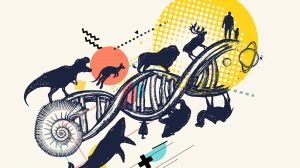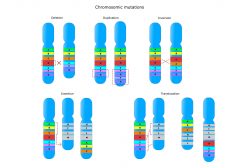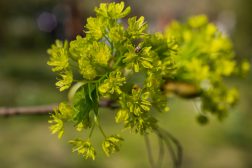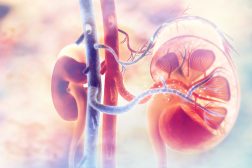
Manubrium
n., plural: manubria or manubriums
[məˈnubɹiəm]
Definition:in human anatomy, handle-like bony segment, such as that of a sternum or of a malleus
Table of Contents
The manubrium is a handle-like structure, as in the manubrium of the sternum or of the malleus. In Latin, it translates to “handle”, which refers to that part of an object designed to hold. Let’s take for instance the manubrium of the sternum, which is located in the upper part of the sternum (or breastbone). It connects to the clavicle and first rib. The manubrium functions as a point of attachment for muscles and bones in the chest and shoulders and helps protect vital organs such as the heart and lungs.
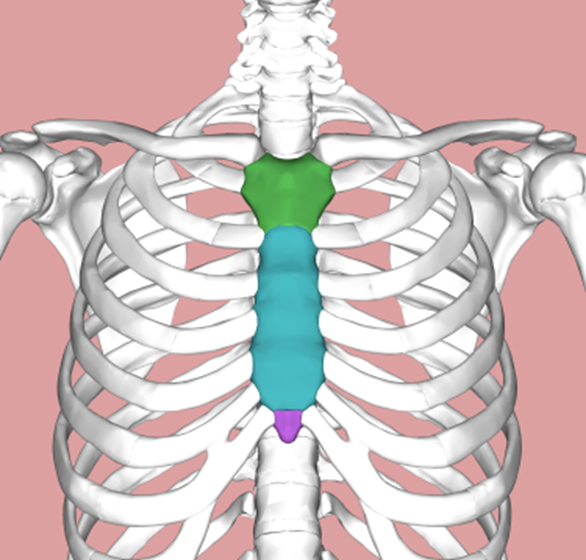
The manubrium is one of the three bones that make up the sternum, which is a narrow, flat bone that forms the middle portion of the front of the chest. The collarbones are held up by the top of the sternum, which also connects to the costal cartilages of the first two pairs of ribs. The sternopericardial ligaments attach the sternum’s inner surface to the heart, and the sternocleidomastoid muscle attaches the sternum’s top to the heart. The sternum consists of three main sternal segments, listed from the top:
- Manubrium
- Body (gladiolus)
- Xiphoid process
The manubrium is the upper part of the sternum where the T3 and T4 vertebrae meet. It makes up the anterior mediastinum’s superior wall and the superior border of the upper thoracic opening. The manubrium’s upper border also acts as the point where the neck’s anterior triangle begins. (Radiopaedia.org, 2023)
Watch this vid about manubrium:
What is Manubrium in Anatomy?
In human anatomy, the manubrium is the handle-like bony process, as that of the anterior segment of the sternum (or presternum) or of the malleus.
Manubrium of the sternum
The anterior aspect of the manubrium is smooth and slightly convex, and it is covered by skin, fascia, and subcutaneous tissue. It also contains the suprasternal notch, which is a shallow depression located at the top of the bone between the clavicular notches. The suprasternal notch is an important landmark for identifying the level of the trachea.
The superior aspect of the manubrium is rough and irregular, and it articulates with the right and left clavicles (collar bones) at the clavicular notches. The clavicular notches are located on either side of the suprasternal notch and are important for stabilizing the clavicles and for allowing movement of the shoulders.
The lateral surface of the manubrium is broad and slightly concave, and it articulates with the first ribs at the first costal cartilage notches. The costal notches are located on either side of the inferior border and are important for stabilizing the ribs and for allowing movement of the chest during breathing.
The posterior aspect of the manubrium is rough and irregular, and it is covered by the sternohyoid and sternothyroid muscles, which are important for swallowing and speaking.
The manubrium is composed of three regions: the superior border, the lateral border, and the inferior border. The superior border is the uppermost edge of the manubrium and is located beneath the clavicles (collar bones). The lateral borders are the outermost edge of the bone and are curved to articulate with the first rib on either side. The inferior border is the lower edge of the manubrium, which articulates with the body of the sternum below.
The manubrium also has a suprasternal notch, which is a shallow depression located at the top of the bone between the clavicular notches. It is an important landmark for identifying the level of the trachea and for performing chest compressions during cardiopulmonary resuscitation (CPR).
The clavicular notches are located on either side of the suprasternal notch and articulate with the clavicles. The clavicular notches are important for stabilizing the clavicles and for allowing movement of the shoulders.
The costal notches are located on either side of the inferior border and articulate with the first two ribs. They are important for stabilizing the ribs and for allowing movement of the chest during breathing.
In manubrium, there are two intercostal spaces, located between the first and second ribs and between the second and third ribs. (IMAIOS, 2023)
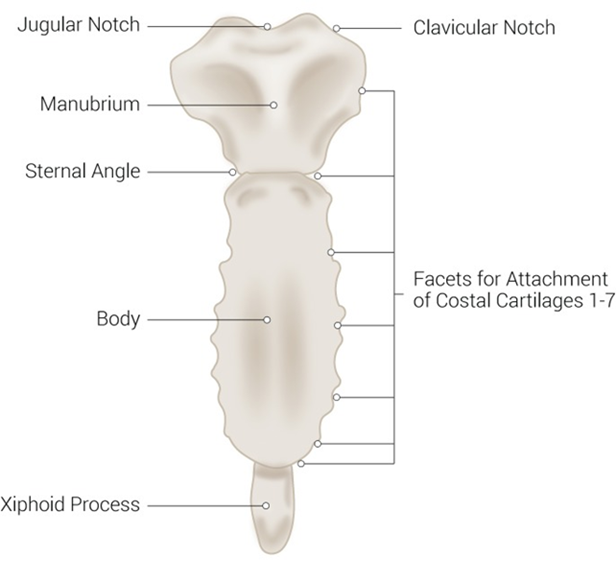
Manubrium of the malleus
The manubrium of the malleus is the lower part of the malleus that connects to the tympanic membrane. The manubrium of the malleus pulls the tympanic membrane inward (towards the cavity of the middle ear). Thus, it helps form the conical shape of the tympanic membrane.
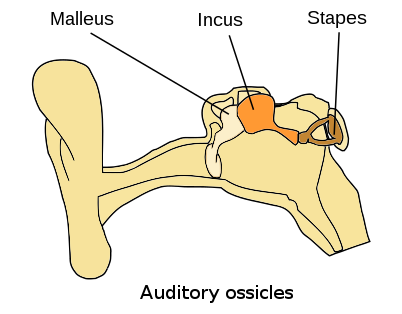 | 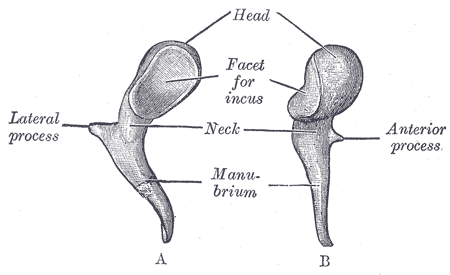 |
| Figure 3: Malleus of the auditory ossicles (left) and the different parts of the malleus, including the manubrium (bottom, right). Image Credit: public domain. | |
Manubrium of jellyfish
Not all manubria are bony structures. In jellyfish, which is an invertebrate animal, its manubrium is a tube that connects to the gastric cavity of the jellyfish.
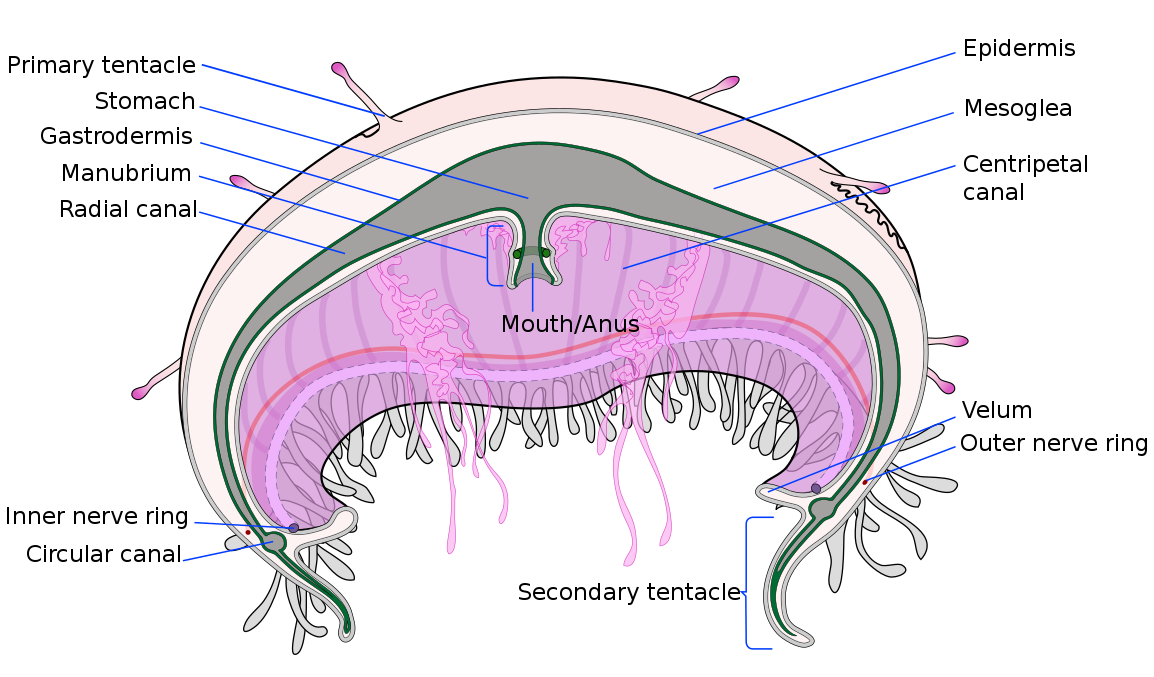
Biology definition:
Manubrium, in anatomy, is a handle-like segment of the sternum (breastbone) or of the malleus of the ear. In zoology, it is a central bodily structure of the jellyfish that is a tube connected to the gastric cavity. Etymology: in Latin, literally means “handle”, from Latin “manus”, meaning hand
In the next sections, we will focus on the manubrium of the sternum, its gross anatomy, features, and other information.
Gross Anatomy
The manubrium is the widest and most superior part of the bone. It is a roughly triangular-shaped bone that is wider at the top and tapers downwards. It is roughly 5 cm long, 6 cm wide at its widest point, and 3 cm thick.
The anterior surface of the manubrium is smooth and slightly convex. Conversely, the posterior surface is rough and irregular due to the attachment of several muscles.
The manubrium is an important attachment site for several muscles and ligaments, including the sternocleidomastoid muscle, the sternothyroid and sternohyoid muscles, and the first pair of ribs. It also plays a vital role in protecting the heart, lungs, and major blood vessels located in the chest.
Articulations
The manubrium articulates with several important structures, including the clavicles, the first two ribs, and the body of the sternum.
- The clavicular notches on the manubrium articulate with the medial ends of the clavicles, forming the sternoclavicular joints.
- The costal notches on the manubrium articulate with the first two ribs, forming the sternocostal joints.
- The manubrium articulates with the body of the sternum at the sternal angle. The sternal angle is an important landmark for identifying the level of the second rib and for performing certain medical procedures.
- The manubriosternal joint, also known as the sternomanubrial joint or the sternal angle, is the point where the body of the sternum articulates with the manubrium. It is located at the level of the second rib and can be easily identified as a horizontal ridge on the anterior surface of the sternum.
The manubrium is an important bone in the human body that plays a crucial role in protecting the heart, lungs, and major blood vessels. It has several anatomical features and articulations that are important for its function and for the overall function of the chest and shoulder region.
Clinical Notes
The manubrium is an important clinical landmark and is involved in several clinical conditions and procedures. Here are a few clinical notes related to the manubrium: (Yang et al., 2017)
- CPR: During cardiopulmonary resuscitation (CPR), the manubrium is an important landmark for chest compressions. The chest compressions are applied over the lower sternum, with the heel of the hand placed on the manubrium and the other hand placed on top of the first hand.
- Sternotomy: The manubrium can be surgically divided (sternotomy) to gain access to the thoracic cavity for procedures such as coronary artery bypass surgery or aortic valve replacement.
- Sternal fractures: The manubrium is susceptible to sternum sternal fractures in cases of trauma, such as motor vehicle accidents or falls. Sternal fractures involving the manubrium can be associated with significant morbidity and mortality, particularly if they involve damage to the heart, lungs, or major blood vessels.
- Costochondritis: Inflammation of the costal cartilage, which connects the ribs to the sternum, can cause pain and tenderness in the chest. Costochondritis commonly affects the cartilage of the second or third rib, which attaches to the manubrium.
- Tietze syndrome: This is a rare inflammatory condition that affects the costochondral junctions, causing swelling and pain in the chest. Tietze syndrome often affects the cartilage of the upper ribs, which attach to the manubrium.
Additional Features
Here are some additional details about the manubrium:
- Embryonic origin: The manubrium develops from two separate cartilaginous structures that fuse during fetal development. The upper part of the manubrium develops from the clavicular process of the first branchial arch, while the lower part develops from the sternum.
- Articulation with clavicles: The manubrium articulates with the clavicles at the clavicular notches, forming the sternoclavicular joints. These joints are important for shoulder movement and stability.
- Thymus gland: The manubrium has a groove on its posterior surface that accommodates the thymus gland, which is a glandular organ involved in immune system function. The thymus gland is typically larger in infants and children and gradually decreases in size during adolescence and adulthood.
- Sternothyroid muscle: The sternothyroid muscle originates from the posterior surface of the manubrium and inserts onto the thyroid cartilage of the larynx. This muscle is involved in vocalization and swallowing.
- Accessory ossicle: The manubrium can sometimes have an accessory ossicle, which is a small bony fragment that separates from the main bone during development. This is a relatively rare finding and is usually asymptomatic.
- Age-related changes: The manubrium undergoes age-related changes, including ossification of the costal cartilage attachments and changes in shape and size. These changes can be important to consider when interpreting imaging studies of the chest.
- Sternal foramen: The manubrium can sometimes have a sternal foramen, which is a small hole or opening in the bone. This foramen is a normal anatomical variation and is usually asymptomatic, but it can sometimes be mistaken for a pathological condition such as a gunshot wound or sternal fracture.
- Jugular notch: The superior border of the manubrium has a V-shaped indentation called the jugular notch, which is an important landmark for anatomical and clinical measurements of the neck and chest.
- Cranial nerves: The manubrium is close to several important cranial nerves, including the vagus nerve, the glossopharyngeal nerve, and the hypoglossal nerve. Damage to these nerves can occur in cases of severe trauma or surgical procedures involving the neck and chest.
- Mediastinal lymph nodes: The anterior surface of the manubrium is in contact with several important mediastinal lymph nodes, which can be involved in the spread of various cancers and infections.
- Blood supply: The manubrium is supplied with blood by the superior thoracic artery and the anterior intercostal arteries. These arteries are important for the nourishment of the bone and surrounding tissues.
- Cleft sternum, also known as sternal cleft or congenital sternal defect, is a rare condition where the breastbone or sternum does not form properly during fetal development. This results in a visible gap or split in the sternal body, which may be accompanied by other abnormalities of the chest wall and underlying organs. (Fokin, 2000)
Overall, the manubrium is a unique bone with several interesting anatomical and developmental features. Its articulation with the clavicles, accommodation of the thymus gland, and attachment of important muscles are just a few of the features that make the manubrium a unique and important bone in the human body.
Note it!
What is the clinical significance of a fractured manubrium?
A fractured manubrium can result in serious complications, such as injury to the heart, lungs, or major blood vessels, and may require surgical intervention to repair.
Take the Manubrium – Biology Quiz!
References
- Fokin, A. A. (2000). Cleft sternum and sternal foramen. Chest surgery clinics of North America, 10(2), 261-276.
- IMAIOS. (2023). Manubrium of sternum. Retrieved 09 April, 2023, from https://www.imaios.com/en/e-anatomy/anatomical-structure/manubrium-of-sternum-1537019684
- Kenhub. (2023). Sternum. Retrieved 09 April, 2023, from https://www.kenhub.com/en/library/anatomy/sternum
- Radiopaedia.org. (2023). Manubrium. Retrieved 09 April, 2023, from https://radiopaedia.org/articles/manubrium
- Yang, M., Jiang, H., Yu, X., Chen, W., Li, Q., Zhang, Y., & Pan, B. (2017). Sternal development and variations and anomalies in patients with microtia: evaluation using 3-dimensional computed tomography. Journal of Computer-Assisted Tomography, 41(5), 784-791.
©BiologyOnline.com. Content provided and moderated by Biology Online Editors.



